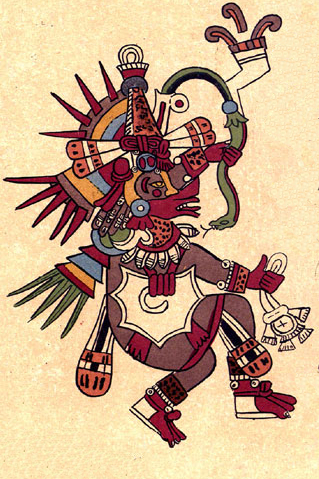Ce Acatl Topiltzin facts for kids
Quick facts for kids Ce Acatl Topiltzin |
|
|---|---|
| Emperor of the Toltecs | |
 |
|
| Reign | 923–947 |
| Predecessor | Xochitl |
| Successor | Matlacxochtli |
| Born | 895 Tepoztlán, Toltec Empire |
| Died | 947 Tlapallan, Gulf of Mexico |
| Father | Mixcōatl |
| Mother | Chimalman |
| Religion | Toltec religion |
Cē Ācatl Topiltzin Quetzalcoatl (meaning Our Prince One-Reed Precious Serpent) was a very important leader from ancient Mesoamerica. He lived around 895 to 947 AD. People in the 16th century wrote about him.
He was known as a ruler of the Toltec people in the 10th century. The Toltecs were an ancient civilization. They controlled the Valley of Mexico long before the Aztecs lived there. Later, he became a legendary figure. People sometimes mixed up his story with the god Quetzalcoatl. In El Salvador, people say he founded the city of Cuzcatlán.
Contents
The Story of Topiltzin Quetzalcoatl
Topiltzin Cē Ācatl Quetzalcōatl was a powerful leader of the Toltec people. He ruled their main city, Tollan.
His Early Life and Rise to Power
He was born around 895 AD. This was in a place now called Tepoztlán. His father was often said to be Mixcoatl, the god of war and hunting. Mixcoatl was also thought to be an earlier Toltec king. His mother was usually known as Chimalman.
Not much is known about his early childhood. But everyone agrees he was a brave warrior. He also became a respected priest for the people of Tollan.
Ruling the Toltecs
Topiltzin became the leader of the Toltecs. He moved his people to Tollan. He ruled during a time of peace and success. He taught the Toltecs many important ideas about how to live in a civilized way. His followers saw him almost like a god on Earth. They believed he had powers similar to the god Quetzalcoatl.
He changed old traditions. He stopped the practice of human sacrifice during his rule. He loved his people and wanted them to offer only snakes, birds, and other animals to the gods. To show his devotion, he created a special way of worship. This included priests living a pure life and avoiding anything that could make them lose control.
Because he was so pure and wise, Topiltzin Quetzalcoatl was loved by his people. He was respected for many generations. Later rulers would say they were related to him. This helped them prove they had the right to be king.
His Departure from Tollan
According to legend, Topiltzin left Tollan around 947 AD. He was about 53 years old. He traveled to the Gulf coast, to a place called Tlillan-Tlapallan. There, he got into a canoe and disappeared. Some stories say he burned himself.
After he left, other leaders used his name to keep the royal family going. The Aztecs also used his name. This helped them rule over the Toltecs more easily.
The Myth of His Return
The Florentine Codex tells a famous Aztec legend. It says that the god Quetzalcoatl would one day return. When the Spanish explorer Hernán Cortés arrived in 1519, the Aztec Emperor Moctezuma II thought Cortés might be the returning Quetzalcoatl.
Some historians believe this idea helped lead to the fall of the Aztec empire. However, most modern experts see this "Quetzalcoatl/Cortés myth" as a story that grew after the Spanish conquest.
Topiltzin's Lasting Impact
The stories say that Topiltzin traveled across Mesoamerica. He founded small towns and gave names to many places. The Aztecs believed he went across the sea to the east. From there, he promised to return one day. He would come back to reclaim his city, Cholula.
Other stories say he would not return himself. Instead, he would send messengers to warn or judge the people. Aztec rulers used the myth of Topiltzin to strengthen their power. They claimed to be his direct descendants. This meant they had the right to rule until he returned.
These myths greatly affected the Aztec empire. They even played a role when the first Spaniards arrived. The Aztecs might have truly believed that Hernán Cortés was the famous priest returning. Cortés came from the east, wore shiny armor, and had four companions. The Aztec rulers were scared. They feared they would lose their power. But the common Aztec people, who were heavily taxed, hoped these newcomers would bring peace. In the end, the Aztec rulers lost their power, and the people were not freed from hardship.
When the Spanish conquered Mesoamerica, they destroyed many ancient writings. The story of Topiltzin Quetzalcoatl was almost lost. Only recently have accurate translations of his story become available. Even these accounts are just a part of the full story. Details can change from region to region, as myths often do over time.
What He Wore
Topiltzin Quetzalcoatl is often shown with special clothing. He usually has a feathered headdress. He carries a curved stick called a chicoacolli. He also has a shield with feathers around the edge. On the shield is the ehecacozcatl emblem, which looks like a wind jewel.
See also
 In Spanish: Ce Ácatl Topiltzin Quetzalcóatl para niños
In Spanish: Ce Ácatl Topiltzin Quetzalcóatl para niños
- List of people from Morelos, Mexico

